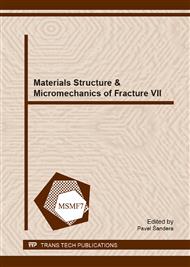[1]
G.R. Johnson and W. H Cook, Fracture characteristics of three metals subjected to various strains, strain rates, temperatures and pressures. Engineering fracture mechanics, Vol. 21 (1985) pp.31-48.
DOI: 10.1016/0013-7944(85)90052-9
Google Scholar
[2]
FA McClintoock, A criterion for ductile fracture by growth of holes, Transactions of the ASME journal of applied mechanics, Vol. 35(1968) pp.363-371.
Google Scholar
[3]
J. Lemaitre, A continuous damage mechanics model for ductile fracture, Journal of engineering materials and technology, Vol. 107 (1985) pp.83-89.
DOI: 10.1115/1.3225775
Google Scholar
[4]
N. Bonora, Nonlinear CDM model for ductile failure, Engineering fracture mechanics, Vol. 58(1997) pp.11-28.
DOI: 10.1016/s0013-7944(97)00074-x
Google Scholar
[5]
S. Chandrakanth and PC. Pandey, An isotropic damage model for ductile material, Engineering fracture mechanics, Vol. 50(1995) pp.457-465.
DOI: 10.1016/0013-7944(94)00214-3
Google Scholar
[6]
Y. Bao, T. Wierzbicki, On fracture locus in the equivalent strain and stress triaxiality space, International journal of mechanical sciences, Vol. 46(2004) pp.81-98.
DOI: 10.1016/j.ijmecsci.2004.02.006
Google Scholar
[7]
Y. Bai, T. Wierzbicki, A new model of metal plasticity on fracture with pressure and lode dependence, International journal of plasticity, Vol. 24(2008) pp.1071-1096.
DOI: 10.1016/j.ijplas.2007.09.004
Google Scholar
[8]
M. Giglio, A. Manes, F. Viganò, Ductile fracture locus of Ti-6Al-4V titanium alloy, International journal of mechanical science, Vol. 54 (2012) p.121–135.
DOI: 10.1016/j.ijmecsci.2011.10.003
Google Scholar
[9]
M. Giglio, A. Manes, F. Viganò, Numerical simulation of the slant fracture of a helicopter's rotor hub with ductile damage failure criteria, Fatigue and Fracture of Engineering Materials and Structures, Vol. 35(2012) p.317–327.
DOI: 10.1111/j.1460-2695.2011.01622.x
Google Scholar
[10]
H. Li. M.W. Fu, J. lu and H. Yang, Ductile fracture: experiments and computations, International journal of plasticity, Vol. 27(2011) pp.147-180.
DOI: 10.1016/j.ijplas.2010.04.001
Google Scholar
[11]
N. Bonora, A. Ruggiero, L. Esposito, D. Gentile, CDM modeling of ductile failure in ferritic steels: assessment of the geometry transferability of model parameters, International journal of plasticity, Vol. 22(2006) p.2015-(2047).
DOI: 10.1016/j.ijplas.2006.03.013
Google Scholar
[12]
N. Allahverdizadeh, A. Manes, M. Giglio, Identification of damage parameters for Ti-6Al-4v titanium alloy using continuum damage mechanics, Materialwissenschaft und Werkstofftechnik, Vol. 43, No. 5(2012) pp.435-440.
DOI: 10.1002/mawe.201200978
Google Scholar
[13]
M. Dunand and D. Mohr, Hybrid experimental-numerical analysis of basic ductile fracture experiments for sheet metals, International journal of solids and structures, Vol. 47(2010) pp.1130-1143.
DOI: 10.1016/j.ijsolstr.2009.12.011
Google Scholar


